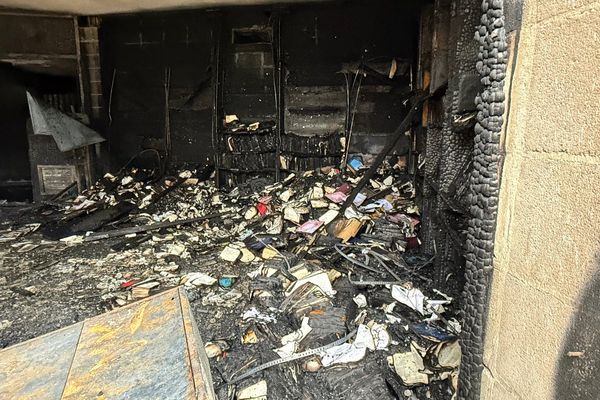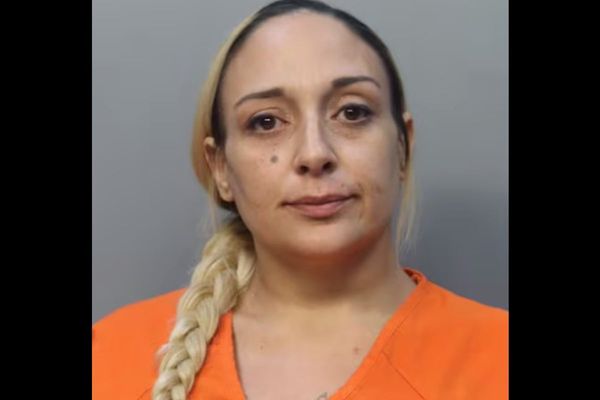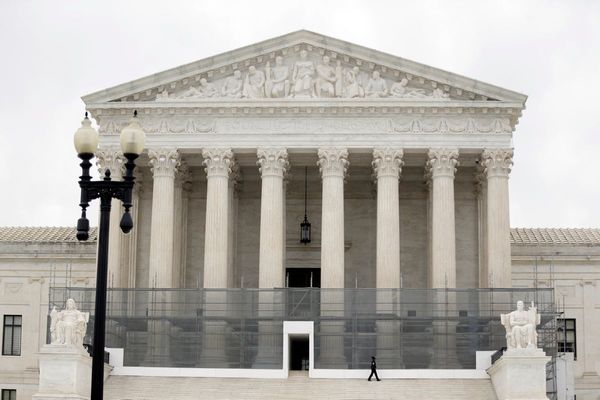New evidence uncovered by the ABC has linked many Thai and Cambodian artworks sold in Australia to looted historic sites and a shady Bangkok dealer.
The Cambodian Government has seized upon the ABC's findings and is calling on Australian galleries to return suspicious cultural artefacts "unless they can demonstrate they legally possess them".
The revelations potentially taint the supply chain of works in public and private collections in Australia and abroad.
Experts have long feared many Khmer artefacts which left the country during Cambodia's decades of civil unrest may have been looted.
The artworks continue to hold deep religious and spiritual significance for Cambodians who want them returned.
Unmasking the mysterious 'Thai dealer'
Many of the Thai and Cambodian works that came to Australia in the 1960s and 70s were imported by the David Jones Art Gallery, a now-closed offshoot of the department store.
The David Jones Art Gallery helped set the decorating style of that period. Under the leadership of Robert Haines, the gallery helped to popularise the display of South-East Asian artefacts not just to the elite but to a broader clientele in Australia.
Background Briefing has traced artefacts sold by the David Jones Art Gallery to some of Australia's most significant South-East Asian art collections, including items in the National Gallery of Australia, the Art Gallery of New South Wales, the Art Gallery of South Australia and the National Gallery of Victoria.
The David Jones Art Gallery's sales records give a snapshot of their clientele.
They include a cross-section of prominent Australians and international figures. Among them are former World Bank president Sir James David Wolfensohn; Lady Schlink — also known as Dr Margaret Mulvey, the pioneering gynaecologist; Princess Diana's stepfather, Peter Shand Kydd; Sir Nicholas Sekers, a British-based industrialist; newspaper owner James Fairfax and others.
However, Background Briefing can reveal one major supplier to the David Jones Art Gallery was implicated in a landmark US art theft case, where evidence suggested that he falsified provenance and worked with a notorious accused art smuggler.
The supplier, Chinese-Thai art dealer Peng Seng, also known as Arthorn Sirikantraporn, worked with accused art smuggler Douglas Latchford to falsify provenance details and help smuggle items, according to evidence in the case.
Peng Seng's ties to Douglas Latchford are highly significant.
During the 60s and 70s, Thailand was a gateway for stolen Khmer artefacts smuggled across the border.
Among the many Khmer art dealers who operated out of Thailand, none are as notorious as Latchford.
In 2012, the Bangkok art dealer was revealed as being at the centre of a US investigation into the sale of a looted Cambodian temple guardian by auction house Sotheby's.
He was later charged with smuggling offences in 2019, when prosecutors alleged his artefacts were the product of "looting, unauthorised excavation and illicit smuggling", and that he had covered up their origins by creating false provenance.
"Latchford built a career out of the smuggling and illicit sale of priceless Cambodian antiquities, often straight from archaeological sites, in the international art market," US attorney Geoffrey Berman said at the time.
Latchford died in 2020 before he could face trial.
The David Jones Art Gallery supplier, Peng Seng, was referred to in the 2019 indictment against Latchford under the alias "the Thai Dealer".
His identity can now be revealed, after the ABC obtained an unredacted 1974 letter detailing his involvement and collusion with Latchford in falsifying provenance records. The letter, which was from a prominent London-based auction house at the time, was put forward as evidence by US prosecutors in their recent case against Latchford.
It describes how Peng Seng would falsify provenance paperwork:
"I have explored extensively with Peng Seng and Latchford how to get ‘legitimate' papers for the large koh ker [sculpture] and for all subsequent shipments," the letter reads.
"Peng Seng will send us a letter written and signed by somebody in Bangkok. He will say that he has seen the piece in Peng Seng's shop three years ago. Peng Seng would like us to give him the exact text that we want in this letter."
It goes on to describe how pieces could be labelled so as to potentially confuse customs officials:
"On all future shipments of important pieces only, both Peng Seng and Latchford will ship the pieces the way they have always done, [and] at more or less the same time will send a modern piece of about the same size and same subject described on the airway bill in such a way that nobody will know to which piece the airway bill applies."
Prehistoric artefacts in question
Further evidence obtained by Background Briefing shows Peng Seng may also have illegally exported prehistoric artefacts out of Thailand and into Australia.
A series of correspondence with the David Jones Art Gallery from 1972 suggests Peng Seng may have been circumventing Thai export controls to remove precious neolithic Thai pottery, known as Ban Chiang antiquities.
Ban Chiang pottery is around 5,000 years old. The site of its discovery in Thailand was described by UNESCO as "the most important prehistoric settlement so far discovered in South-East Asia".
The Prime Minister of Thailand specifically banned its export in 1972.
Shortly after that Peng Seng wrote to the David Jones Art Gallery director, Robert Haines:
"We are sorry to inform you that the Thai Government has only lately put a ban on selling these pottery here … Nevertheless, it does not mean that we could not supply you again in the future. You know what we mean!"
Despite the warning, the correspondence indicates the David Jones Art Gallery continued to request and purchase the items well into 1973.
The National Gallery of Australia (NGA) and the Art Gallery of New South Wales (AGNSW) bought a number of Ban Chiang vessels from the David Jones Art Gallery in 1973. However, it is unclear whether these were exported from Thailand before or after the ban.
The gallery's director Robert Haines told a newspaper at the time the items were brought over prior to the ban; however, correspondence shows he continued to seek out their purchase from Thailand afterward.
Close friends of Haines told Background Briefing he would never knowingly accept stolen artworks or work with art dealers who falsify provenance.
'Substantial concerns'
Peng Seng was one of a number of dealers supplying the gallery during this period, and it's unclear which artefacts sold to major galleries were supplied by him.
Phoeurng Sackona, Cambodia's Minister of Culture and Fine Arts, told Background Briefing the connection should be further investigated.
"We are aware of several dealers who have trafficked in stolen Cambodian antiquities," she said.
Minister Sackona said that galleries who possess suspicious items without legal title should return them.
"We ask Australian galleries to return such cultural properties unless they can demonstrate they legally possess them."
The head of the NGA's provenance project Bronwyn Campbell told Background Briefing "the connection [with Peng Seng] will be taken into account as part of our review of David Jones [Art Gallery] acquisitions".
"If we're sure that something has been illegally obtained or unethically obtained, we would consider repatriating it. And when I say sure, I mean more than 50 per cent certain," she said.
'Disturbing provenance'
The Background Briefing investigation has also identified a number of other suspicious artworks in major collections.
Some were identified as coming from areas known to be the subject of extensive looting. Others passed through the hands of Australian collectors and now feature prominently in major galleries across the world.
For example, a lintel or stone wall panel from a temple was photographed on the ground in Cambodia in 1969. An identical lintel now appears at the Norton Simon Museum in California after being purchased from Latchford.
An early 8th century Bodhisattva Avalokiteshvara statue from western Cambodia sits in the Metropolitan Museum of Art, after originally being owned by Australian art collector Alex Biancardi.
Background Briefing has obtained an early black-and-white photograph of what appears to be the same work which was found on the computer of accused smuggler Latchford. It was within a collection of records labelled 'Spinks' [a London-based auction house] on his computer.
Another work — a large five-headed stone serpent — was in the collection of Australian architect and furniture designer, Douglas Snelling.
A 1974 catalogue describes the artefact as originating from Preah Vihear, the temple site which sits on the Cambodian-Thai border and was the subject of extensive looting.
The same item now resides at the Norton Simon Museum.
Another item owned by Douglas Snelling, a sandstone head of Vishnu, was attributed to a "temple at Phimai".
Phimai is a site of important Angkorian ruins in north-east Thailand. It was declared a protected site in 1936 by the Thai government.
'We had to smuggle out of Thailand'
Douglas Snelling was among the biggest collectors of South-East Asian antiquities of his time and, at one time, the Honorary Consul-General of Cambodia.
In a 1965 letter obtained by Background Briefing, he describes "smuggling" Cambodian items out of Thailand:
"Apart from some small bronzes given to us by the Royal Family in Cambodia, we acquired our other Angkor pieces outside the borders of Cambodia. Some of these we had to smuggle out of Thailand, even though they were originally stolen from Angkor," he said in the letter.
He continues:
"One of the bronzes we bought for something like $US20 has been valued by a New York art dealer in excess of $100,000. This sounds crazy I know, but similar extraordinary values apply to all the pieces we have, and we now have about 20. You can imagine our excitement at acquiring these right at the source, and the excitement of ultimately getting them freighted home."
One item described in this letter was a 180-kilogram seven-headed snake known as a Naga, carved out of basalt. A similar piece was later photographed in Snelling's Sydney home in 1966, but has never been found.
In the late 70s, much of Snelling's extensive collection was sold off. With the help of South-East Asian art scholar Angela Chiu, Background Briefing has visually matched pieces from his collection. The works appear to be held by prominent US galleries including the Los Angeles County Museum of Art and the Chicago Institute of Art.
The Chicago Institute of Art told Background Briefing that it continuously researches the provenance of its collection and that its records on Snelling's objects did not indicate provenance issues.
A spokeswoman from the Los Angeles County Museum of Art said "the museum actively researches claims and inquiries made about objects in its collection and appreciates any additional documentation ... [that] anyone else may be able to share to assist in those efforts."
Taking on the museums
Angela Chiu has been working with Background Briefing to track down South-East Asian artefacts with suspicious provenance.
"They cannot be that on the one hand and, on the other hand, close off discussion or fail to be open about the origins of their collections."
Chiu said often museums set the bar too high for repatriation.
"They decide what their own standard of proof is and, unfortunately, this can be unrealistic … so you have to wonder whether some of what museums are demanding now is not actually due diligence but instead ways to avoid having to repatriate something."
Vishnu head found in NSW garage
Not all items investigated by Background Briefing ended up in galleries or museums or were sold at auction.
An 8th century Vishnu head, once belonging to collector Alex Biancardi, was found in his relative's garage next to a stack of firewood.
Egyptian-born Australian businessman Alex Biancardi was one of the world's most significant collectors from the 1960s to the 80s.
Many of his items were either gifted to or purchased by the AGNSW following his death in 1998. Others can be found in London’s Victoria and Albert Museum, and in Sydney’s Museum of Applied Arts and Sciences.
A 1974 letter from London auction house Spink, obtained by Background Briefing, suggests Biancardi was in personal contact with accused smuggler Douglas Latchford.
"Latchford offered the [sculpture] directly to Biancardi in Paris by photograph," the letter reads.
There is no evidence Biancardi knowingly purchased stolen goods at the time.
Cambodia speaks out
The NGA is currently negotiating the return of a Cham Padmapani statue with the Cambodian Government, after it was linked to Douglas Latchford.
Cambodia's Culture and Fine Art Minister Phoeurng Sackona said the NGA "has thus far been cooperative and forthright".
The Cambodian Government has been contacting galleries across the world appealing for the return of items removed without proper authorisation in the 1960s and '70s.
"Cambodia has never, really, given permission for any objects to go out," said the Cambodian Ministry of Culture's chief legal counsel and the head of its investigative team, Bradley Gordon.
"So when we're talking to museums and private collections, we're saying to them, 'If you possess these Khmer objects, you should prove to us you have legal title', because we know the answer is going to be they don't have it.
Cambodian archaeologist Sopheap Meas has been interviewing villagers to help to trace looted artefacts.
She said the artefacts continue to have a deep spiritual value to many Cambodians decades after they were removed.
"It's like they lost an ancestor; they've lost their ancestral spirit," she said.
The Cambodian Government is now working with former looters who are helping to identify and trace works overseas. In many cases, it is not seeking for items to be returned but rather for an acknowledgement that an item may have been stolen, and is in fact the legal property of the Cambodian Government.
The galleries respond
The Art Gallery of South Australia, which holds an Angkor sandstone dancing figure originally bought from the David Jones Art Gallery, told Background Briefing that it bought the piece following protocols that were widely accepted as professionally rigorous at the time.
"It has now been raised as a work for further provenance research," a spokesperson said.
The National Gallery of Victoria (NGV) purchased a 13th century Palanquin fitting from the David Jones Art Gallery.
When contacted by Background Briefing, the NGV did not respond to questions but a spokesperson said the collection is being digitised to facilitate new and ongoing research including provenance.
The AGNSW's senior curator of Asian art, Melanie Eastburn, said that the gallery was examining its collection of Biancardi items as part of its provenance project.
"Although they come from the same source ... their ownership histories and provenance is completely varied, so we can't make any assumptions that because one has a particular history that any other would have the same history," she said.
The AGNSW said it is also researching the provenance of its Ban Chiang pottery, using archives of the David Jones Art Gallery.
Sydney's Museum of Applied Arts and Sciences, which has two Khmer objects once owned Alex Biancardi, said it engaged an independent expert to "authenticate and value" the objects before purchase.
The items were passed to another collector before coming into the museum’s collection.
The Victoria and Albert Museum, which also holds a number of Biancardi works, told Background Briefing that the museum makes much of its provenance information public and that research into its items is continuous.
A spokeswoman from New York's Metropolitan Museum of Art told Background Briefing the gallery had long been reviewing objects connected to Latchford and his associates.
She said that in 2013 the gallery had returned two objects connected to Latchford.
"As we continue our research, we will continue this approach, as is appropriate," she said.
The Norton Simon Museum declined to comment.
Auction house Spink said it no longer had any connection to the company of the same name that operated in the 1960s and '70s, and that it ceased trading in ancient art and antiquities from 2002, when the business was sold to new owners.







